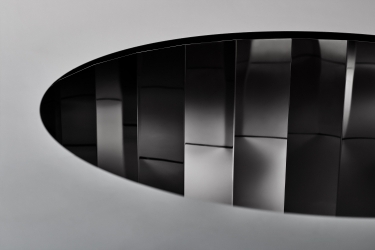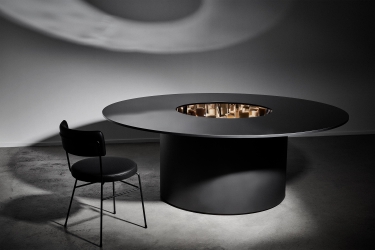Dining is something we all do, in some form or another, everyday—yet its meaning differs from one person to the next. The National Gallery of Victoria’s (NGV) Art of Dining prompts an exploration on the fundamentals that combine to elevate a daily task beyond convention. History is punctuated with diverse dining philosophies, styles and themes; from grand halls of Europe in the Middle Ages, to the Art Deco ballrooms of the 1930s. A focus on ornamentation is increasingly apparent, specifically in the dining table and its centrepiece, or “epergne”. Often thematic and bombastic in scale, the centrepiece has come to occupy the focus both physically and experientially.
This installation for the National Gallery of Victoria’s Art of Dining is a modernist rebuke of the traditional epergne. The object deliberately recedes; its restraint holds space rather than fills it, inviting diners to share this space, and time, with each other, the food and the environment. Surfaces polished to highly reflective states embed snippets of the surrounding environment creating a connection to site. In the context of the Great Hall against Leonard French’s stained-glass ceiling, it provides an opportunity for reflection (both figuratively and literally).
Recessed into the table, the sunken centrepiece faced in polished stainless steel folds, is akin to a hearth, a place to gather around and foster community. The table seats diners with a kaleidoscopic view of their experience, each perspective simultaneously unique and interrelated. It’s less about an idolisation of form and more an exercise in optimising the experience the form fosters.
“By stripping back to the elemental, what remains is an object that supports connection rather than diverting attention.” —Rhys Gorgol, TCYK
A conversation between Pip McCully (PM) from Studio Wonder, Rhys Gorgol (RG) from The Company You Keep and Matt Leach (ML) from Australian Design Radio.
We’re talking about the table installation you created in collaboration. This was for NGV — the National Gallery of Victoria — Art of Dining series, 2019. I’m interested, Rhys — what attracted you to this project, because it’s not your typical design project, is it?
It is not, we’re not dealing with pixels and InDesign here. The starting point was the collaboration — being able to create something outside of a commercial brief with a respected peer. Pip and I have a pretty long relationship. We used to share a studio space together. When Pip showed me the previous events, the kind of work there and what we were asked to do, it seemed like something that could provide a very interesting result when you combine an interior practice and a graphic practice coming together.
Pip, talk to me more about the concept of the table. Because upon first appearance, it seems very much more restrained than some of the other ones I’ve seen on the NGV Instagram.
Most of the participants are interior stylists or interior designers, and so it was quite a unique scenario to be asked in the first place. Especially as we don’t do a lot of styling work — much more functional design and architecture. So when we started to look at the design, it was key to collaborate with Rhys, in terms of potentially approaching the designers, and it’s a version of art direction as opposed to just styling and decoration. So the concept then became much about breaking down what it means to dine, and then how we can produce the most pared-back restrained design response to that. To actually design an experience within the space, as opposed to an ornamental addition to the Great Hall.
I’m interested in that, “pared-back”. Rhys — I read a quote by you that talks about stripping back to the elemental. Is that a design philosophy for your studios?
It’s definitely something that underwrites our approach to design. Design is there to serve a function or for a purpose, and there’s a clarity that comes with economy. So when you don’t shroud an idea or a purpose with external things, or things that are potentially superfluous, then they avoid distracting from the intention of what you’re trying to set out.
I want to talk about that intention a little bit more. Looking at other examples, there was very much this idea of going up and obscuring the view across the table, where your centrepiece seemed to be sunken down. Rhys, how did that come about, what was the idea behind that?
It’s twofold. The approach and the collaboration really followed a conceptual practice rather than an ornamental practice. With the brief being Art of Dining, you start sitting and thinking about what actually constitutes dining. Is dining just the object that you sit on or sit around? Is it the food that you eat, is it the people that you’re sitting with, is it the conversation? It’s all those things and so in creating something, we wanted to create a platform that fostered and elevated that notion of dining. Which is, as I mentioned, all of these kinds of things. So the first thing was to remove any obstruction. If you’ve got something in the centre of the table and you can’t see the eyes of the person across the table, then you’re hindering that conversation about food or service or whatever it happens to be. There’s a practical component to restraining and pulling it down. But also as soon as you start to do that, it starts to be reminiscent of other things — such as a hearth or even a fire around a camping place, which is more community-driven and more fundamental to the desire of people coming together and breaking bread together.
You mentioned the idea of hearth. I’ve seen some images where you’ve got candles in there and it creates almost this fire that everyone is sitting around.
It’s exactly the point. It’s about bringing in intimacy so that we could actually have people sit at the table, be connected to each other, but also there’s an intimate connection to the table by looking down and into the central space. The design was quite key in that it’s a circle, but we designed a mirrored, faceted interior to that central hearth. So that no matter what was positioned or placed within that point, you could get a particular aspect from where you sat at any point of the diameter of the circle.
It became something interesting to us. If you elevate the value of the experience and you remove the power of the object and the physicality of the object, then you start to think about how you can mark that experience. With the candles there’s a kinaesthetic component to it, there’s a movement. And so it is literally passing time and signifying that which is interesting. And there’s these things that are subconsciously happening when people gather around campfires that we don’t really stop and think about. But when you interject them into the hearth or the central component of the table, that humanity, that warmth of that experience, or the connection of breaking bread around this central object, is really brought back.
I love the idea that you got the brief, it was a brief for a table and the first thing you did was work out how you could get rid of the table.
Exactly. How can we design a dining experience?
It’s interesting — in terms of how it sat in context with the other entries or the exhibition as a whole, in that room the general response was grand. There were large gestures and our installation is deliberately restrained because it’s about the sense of intimacy, it’s about the people that are sitting around it. So when that sits in the context of the Great Hall, which is these huge lofting ceilings surrounded by these very loud, grand gestures, it becomes a juxtaposition that then draws people over to it. Because at the start they almost think there’s something wrong. But then as they draw closer they start to understand and reveal it, which means they need to engage with it in a bit more of an intentional way. They can’t just walk around with their periphery and think “I understand this, I understand that”, they have to come over and engage, and that was something that was a really beautiful response to the output.
One of the things to also mention is that a lot of people may not understand the context of where this table is being placed. It’s going in the NGV Great Hall, which has this most amazing stained-glass ceiling across the top. Talk to me more about that Pip, because it’s obviously part of your thinking?
That was key to our thinking. The opportunity to design an object to be placed into that space is super important, so how do we then not then compete with the context? The way we wanted to approach the design was to insert something that only functioned for the purpose of what it was required, but also was highly sympathetic to the context of the space. And in terms of decoration, what more do you need than Leonard French’s stained-glass ceiling in that cavernous beautiful hall, and so why would we need to add anything more to that space, and instead, how can we enhance that? So the highly polished stainless steel surface was key to reflecting that. From wherever you stood you could see that’s what the decoration became, the overlay through that space.
It’s important, the idea of context, not only in terms of people around the table or food on the table, but where that table sits. And the Great Hall in the NGV on St Kilda Road is an epic space, and that stained-glass ceiling is extremely iconic. So if someone has the opportunity to dine in that space, you really want to talk to the cues of that environment that are extremely unique — that heighten or enrich the experience of someone sitting around a table breaking bread.
Creative Director: Rhys Gorgol
Collaborator: Pip McCully, Studio Wonder
Photographer: Daniel Hermann-Zoll











